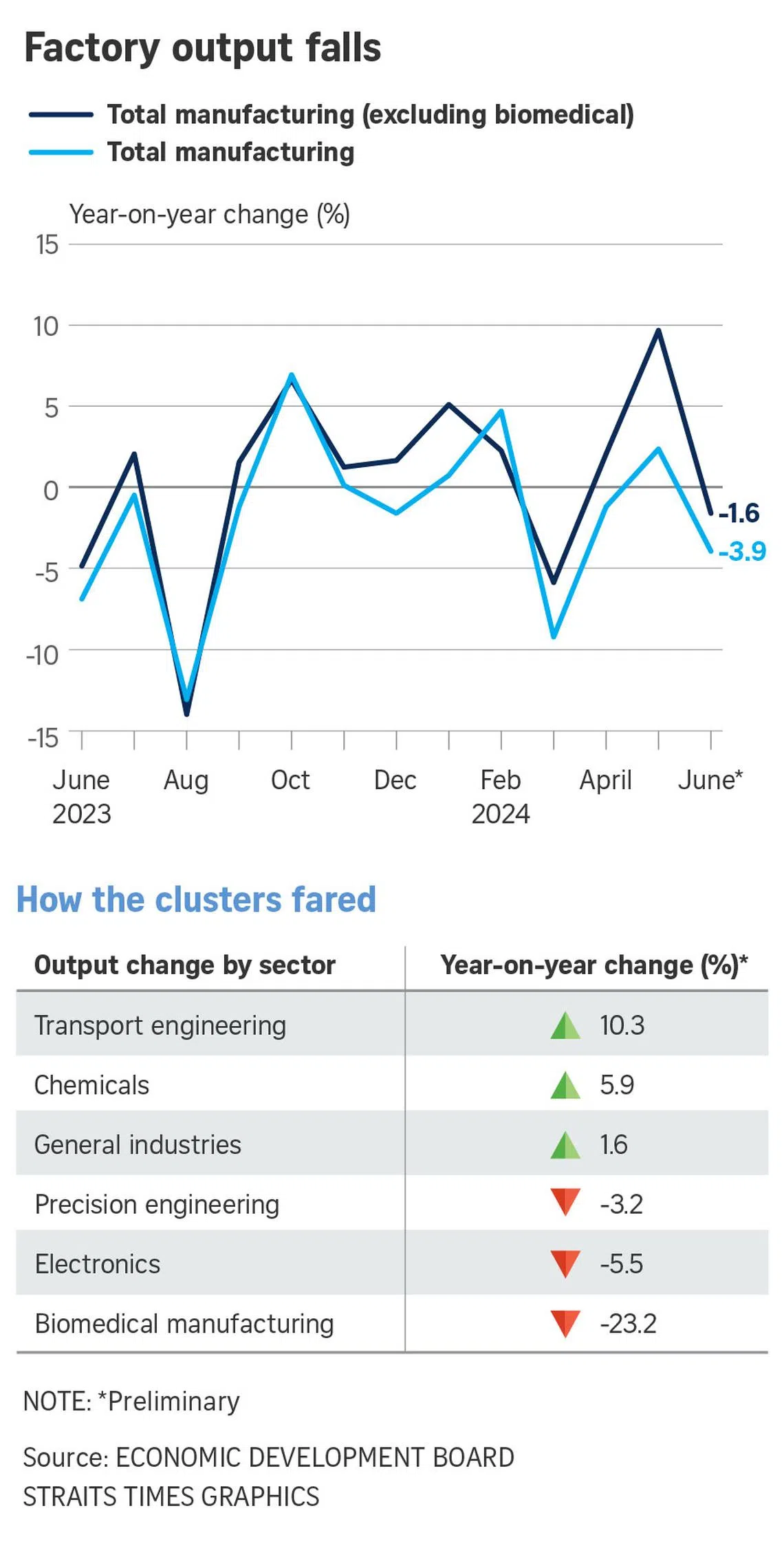Singapore factory output shrinks 3.9% in June, worse than expected
Sign up now: Get ST's newsletters delivered to your inbox

Semiconductors, which make up about 41 per cent of total factory output, shrank 9.4 per cent.
ST PHOTO: KUA CHEE SIONG
Follow topic:
SINGAPORE – Singapore’s manufacturing output shrank in June, reversing from a turnaround in the month before as chip production dropped.
Total output declined 3.9 per cent year on year, after a downwardly revised 2.3 per cent increase in May and a 1.2 per cent drop in April.
Economists polled by Bloomberg forecast a 0.1 per cent contraction in output.
Excluding the more volatile biomedical industry, production slipped 1.6 per cent, data released by the Economic Development Board on July 26 showed.
On a seasonally adjusted month-on-month basis, production decreased by 3.8 per cent in June. Excluding biomedical manufacturing, it fell 6.4 per cent.
The electronics industry, which accounts for nearly half of Singapore’s manufacturing production, saw output drop by 5.5 per cent year on year, after growing a revised 18.6 per cent in May.
Semiconductors – which make up about 41 per cent of total factory output – shrank 9.4 per cent.
Other electronics modules and components rose 6.5 per cent, while computer peripherals and data storage grew 14.3 per cent, and infocomms and consumer electronics production added 20.9 per cent.
Maybank economist Chua Hak Bin said the manufacturing contraction in June suggests that Singapore’s gross domestic product for the second quarter of 2024 may be revised to about 2.7 per cent, down from the Ministry of Trade and Industry’s flash estimate of 2.9 per cent.
He added that port congestion and shipping delays from the Red Sea crisis may be dampening the electronics recovery. He noted that the country’s semiconductor segment is less reliant on the artificial intelligence (AI) chip boom.
“Electronics demand is, however, broadening beyond just AI and Singapore’s electronics recovery will likely strengthen in the second half as a result,” he said.
The biomedical manufacturing industry was the worst performer in June, with production plunging 23.2 per cent over the same month in 2023.
Within the cluster, the medical technology segment increased 11.4 per cent due to export demand for medical devices. But output of the pharmaceuticals segment contracted 47.1 per cent on account of a different mix of active pharmaceutical ingredients being produced compared with a year ago.
Output in the transport engineering sector grew 10.3 per cent in June over the same month in 2023.
The marine and offshore engineering segment led the charge with an expansion of 19.5 per cent, due to a higher level of activity in shipyards and increased production in oil and gas field equipment.
The aerospace segment advanced 12.4 per cent, on account of higher production of aircraft parts and more maintenance, repair and overhaul jobs from commercial airlines.
In the precision engineering industry, output contracted 3.2 per cent year on year with all segments recording output declines.
The precision modules and components segment decreased 0.8 per cent, led by lower output of dies, moulds, tools, jigs and fixtures.
General manufacturing output climbed 1.6 per cent in June, supported by growth in the food, beverages and tobacco segment, which grew 6.9 per cent as a result of higher production of beverage concentrates, milk powder and cocoa products.
The printing segment rose 2 per cent while the miscellaneous industries segment contracted 6.4 per cent, led by lower production of construction-related materials.
The chemicals cluster saw output rise 5.9 per cent year on year. This was largely led by the specialities segment, which expanded 17.3 per cent due to higher production of mineral oil and food additives.
The petroleum and petrochemicals segments grew 7.2 per cent and 3.5 per cent respectively, on the back of a low production base in 2023 due to plant maintenance shutdowns. But the other chemicals segment declined 2 per cent with lower output of fragrances.
DBS Bank economist Chua Han Teng described the Republic’s manufacturing performance in the second quarter of 2024 as “choppy” but indicated a possible gradual but fragile recovery later in the year.
“There is some fragility in Singapore’s manufacturing improvement and we need to continue to keep an eye on ongoing uncertainties, such as geopolitical risks that could disrupt supply chains, the Red Sea crisis and the extent of future US interest rate cuts,” he said.



